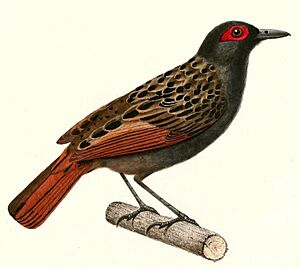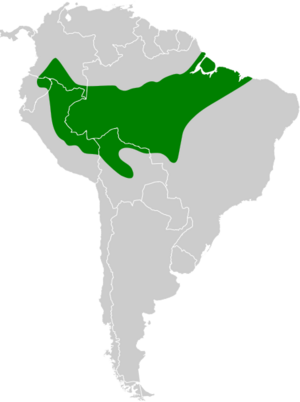Black-spotted bare-eye facts for kids
Quick facts for kids Black-spotted bare-eye |
|
|---|---|
 |
|
| Conservation status | |
| Scientific classification | |
| Genus: |
Phlegopsis
|
| Species: |
nigromaculata
|
 |
|
| Synonyms | |
|
|
The black-spotted bare-eye (Phlegopsis nigromaculata) is a fascinating bird that loves to eat insects. It belongs to a group of birds known as "typical antbirds." You can find this unique bird living in the forests of several South American countries. These include Bolivia, Brazil, Colombia, Ecuador, and Peru.
Contents
About the Black-spotted Bare-eye
How Scientists Name It
Scientists give every animal a special name. This helps everyone know exactly which creature they are talking about. The black-spotted bare-eye was first described by two French naturalists. Their names were Alcide d'Orbigny and Frédéric de Lafresnaye. They gave it its scientific name in 1837. The name nigromaculata means "black-spotted" in Latin.
There are four slightly different types, or subspecies, of the black-spotted bare-eye:
- P. n. nigromaculata
- P. n. bowmani
- P. n. confinis
- P. n. paraensis
What Does It Look Like?
The black-spotted bare-eye is a medium-sized bird. It is about 16.5 to 18.5 centimeters (6.5 to 7.3 inches) long. It weighs around 42 to 51 grams (1.5 to 1.8 ounces). Both male and female birds look very similar.
A cool feature of this bird is the large ring of bare red skin around its eye. This gives it the "bare-eye" part of its name! The main type of this bird, P. n. nigromaculata, has a black head, neck, and throat. Its upper body is light olive green. It has oval-shaped black spots with yellowish-brown edges. Its wing feathers are a cinnamon-red color, and its tail is a reddish-brown. The lower part of its body is olive-brown, turning more reddish towards the tail.
The other subspecies have small differences. For example, P. n. confinis is smaller and has more spots. P. n. bowmani has brighter, more yellowish upper parts. P. n. paraensis has a larger red eye ring and smaller, rounder spots.
Where Does It Live?
The different types of black-spotted bare-eyes live in various parts of South America:
- P. n. nigromaculata lives from south-central Colombia down through Ecuador, Peru, and into southwestern Brazil and northeastern Bolivia.
- P. n. bowmani is found in south-central Brazil and northeastern Bolivia.
- P. n. confinis lives in east-central Brazil.
- P. n. paraensis is found in northeastern Brazil.
These birds prefer humid evergreen forests. They live in lowlands and foothills. They can be found in different forest types, like várzea (flooded forests) and terra firme (dry land forests). They usually live below 800 meters (2,600 feet) in Peru. In other areas like Colombia and Ecuador, they stay below 500 meters (1,600 feet) or 400 meters (1,300 feet).
How It Behaves
Staying in One Place
Scientists believe the black-spotted bare-eye stays in the same area all year round. It does not migrate to other places.
What It Eats
This bird is an "obligate ant follower." This means it absolutely relies on army ant swarms to find its food! As army ants march through the forest, they scare out many small creatures. The black-spotted bare-eye then catches these fleeing arthropods (like insects and spiders).
It usually hunts alone, in pairs, or in family groups. It perches close to the ground, about 1 meter (3 feet) high. From there, it quickly flies or pounces down to catch its prey. Sometimes, it even flips over leaves on the ground to find hidden snacks. Many black-spotted bare-eyes might gather around one ant swarm. They are usually stronger than most other birds that follow ants.
Raising a Family
The breeding season for the black-spotted bare-eye changes depending on where it lives. In Brazil, they breed from August to March. In Peru, it's from October to February. In Ecuador, it seems to be from October to June.
Their nests can look different. Some are flat linings in a tree hole. Others are open cups or flatter bowls. They build their nests using plant materials. This includes bamboo leaves, palm fronds, and thin vines. They often line the nest with soft plant fibers. A female bird usually lays two eggs. The female sits on the eggs at night. Both parents take turns during the day. Young birds leave the nest at least 13 days after hatching.
Its Sounds
The song of the black-spotted bare-eye is a series of short, rich whistles. Each whistle gets a little lower in pitch and sounds a bit rougher. People have described its song as "zhweé, zhwu, zhwu" or "HEEEW heer heer."
It also makes different calls. These include a quick "chip" sound. It also has a long "chirr" that drops in pitch and gets quieter. Another call is a short series of notes that get longer and drop in pitch.
Is It in Danger?
The IUCN (International Union for Conservation of Nature) has listed the black-spotted bare-eye as a species of "Least Concern." This means it is not currently in immediate danger of disappearing. It lives across a very large area.
While its exact population size is not known, it is thought to be slowly decreasing. However, no major threats have been found right now. It is considered uncommon to fairly common in most places where it lives. The bird also lives in several large protected areas. These areas help keep its habitat safe. Even outside protected areas, much of its home seems safe for now.


